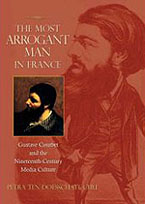The browser will either open the file, download it, or display a dialog.
|
The Most Arrogant Man in France: Gustave Courbet and the Nineteenth-Century Media Culture |
|||
| An 1853 letter to Alfred Bruyas from Gustave Courbet boasts "….I am the proudest and most arrogant man in France." Such self-satisfied claims come as no surprise to those familiar with Courbet's self-representations in painting and in writing. Petra ten-Doesschate Chu may be the scholar most familiar with Courbet's words. It was she, in 1992, who translated and edited a critical edition of over 600 of the artist's letters. Chu's beautifully written recent book, The Most Arrogant Man in France, appears to have originated in the earlier project—in letters expressive of Courbet's ambition "to read about myself in the Paris newspapers" and his savvy ability to make sure he was "surrounded by people very influential in the newspapers and the arts." | ||||
| Courbet's careerism has been a subtext but never the focus of any of the voluminous writings on the painter. Most often, he is invoked to abbreviate the post-Romantic turn in mid-nineteenth century European art from the language and protocols of academic classicism to a Realist orientation in the age of mechanical reproduction. The unavailability of his paintings to traditional iconographical unpacking makes them irresistible to scholars of all stripes. They have been as fertile for T.J. Clark's social historical disquisitions on the ideology of avant-gardism as for Michael Fried's narratives on the genesis of modernism. | ||||
| Unlike previous writers on the artist, Chu is centrally interested in Courbet's career path. Though she, too, is drawn to the artist's oppositional stances, provocative gestures, and borrowings from popular rather than institutionally sanctioned sources, she casts his paintings not as radical acts helping to fuel political change but as elements of an elaborate system of "posing" and "packaging" with which he negotiated the altered landscape of modern art. | ||||
| Pierre Bourdieu's 1992 Les Règles de l'art—the definitive work on the inseparability of art from the social conditions of its production, circulation and consecration—provides a frame for Chu's study. Bourdieu's model of the economy of symbolic capital and cultural power relations, adapted to the topography of nineteenth-century visual culture, provides the lens through which she assesses Courbet's responses to the entrepreneurial imperatives of modern art. It is the system of exhibition and publicity strategies he devised, and the standard it set for generations to come, with which Chu is most concerned. The source for his strategic "rhetoric of independence" and engagement with publicité, she argues, was Paris's "media culture." Courbet emulated the example of contemporary writers in Paris's literary bohemia, the community to which he gravitated upon his arrival in the capitol in 1839, who made their names and livings by capitalizing on opportunities provided by the mass press. Courbet followed suit, turning to the press to publicize his work, cultivate a new kind of celebrity status, and reach larger audiences than the Salon could guarantee. | ||||
| The first three chapters of The Most Arrogant Man in France flesh out Courbet's specific engagement with the press, beginning with the chronological coincidence of his arrival in Paris in the same years that newspaper entrepreneur Emile de Girardin was transforming the nature of journalism. Girardin cut the subscription price of his paper, La Presse, in half, increased advertising space, and introduced the serialized novel—strategies that contributed to exponential increases in the readership of dailies. In addition to the increasing circulation and profitability of the grande presse, the July Monarchy and Second Empire also saw the proliferation of small, specialized newspapers and magazines, many of them illustrated, directed at audiences both popular and elite, male and female. | ||||
| Courbet's career unfolded against the backdrop of a flourishing and increasingly diversified press culture that contributed substantially to the emergence of the exhibition artist. Critic Alexandre de Saint-Cheron's 1832 exposition on the economic independence that the press affords the modern artist, Chu implies, provided a context for Courbet's tactics. Making work visible to a broad spectrum of the population in the pages of the press, Saint-Cheron insists, makes freedom from institutional patronage possible. | ||||
| The book's early chapters establish Courbet's status as a regular at the Brasserie Andler, a gathering place for journalists, printers, and illustrators. It was there he encountered many of the contributors to the grande and petite presse who became friends and advocates, figures like Banville, Baudelaire, Champfleury, and Castagnary. And it was there he appears to have learned to cultivate writers and editors, often through letters that not only called their attention to his work, but provided descriptive language and summaries of his theories that some adopted verbatim. | ||||
| The most original but ultimately disappointing chapter deals with what Chu calls Courbet's "bisextuality," a term coined by Naomi Schor to describe the manner by which George Sand novels and public self-presentation unsettled codes of masculinity and femininity. The work of male writers like Flaubert, Mallarmé and Proust who, as Emily Apter writes, "masqueraded as a woman's consciousness" also has been characterized as "bisextual". And in Courbet's Realism, Michael Fried extrapolates that trope to the artist. But while Fried offers a nuanced psychoanalytic reading of areas of intersection between Courbet's public performance and representational practices, Chu reduces the notion of a bi-gendered Courbet to one more entrepreneurial strategy, this one about capitalizing on "the advantage of the 'woman theme' to an artist wishing to 'make an instant little noise.'" | ||||
| I would have liked to see more of an engagement with the important body of Courbet literature and The Most Arrogant Man in France's position within that corpus. But the book's engaging premise is argued thoroughly and persuasively, and may very well open new possibilities in Courbet studies. | ||||
| Janis Bergman-Carton Associate Professor of Art History Southern Methodist University |
||||



